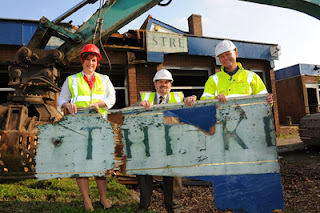The original Woolpack used to stand at the junction of Bolton Road and Eccles Old Road, Pendleton, and can be traced back to 1786. The pub used to have a bowling green and tea gardens which opened in 1829, and the Woopack offered "the very best wines and spirits, London bottled and draught porter and excellent home brewed ale [2]." At this time there was a turnpike for the Eccles Old Road here and there was a horse's water trough outside the Woolpack.
Woolpack, Eccles Old Road, Salford. (c) Neil Richardson & Tony Flynn [3].
By the end of the 19th century the Woolpack was comprised of an original three-storey building with a two-storey extension on the Eccles Old Road side. At this time the pub was advertising Hardy's Celebrated Ales but in 1905 Walkers & Homfray took over. They renovated the pub, tiling the front and adding the distinctive black and white timber detail [2].
Woolpack, Eccles Old Road, Salford. (c) Neil Richardson [2].
Landlord of the newly refurbished Woolpack was Robert Valentine, then a Manchester United player, and he relaid the bowling green and built a bowling house out the back. The Woolpack passed to Wilsons Brewery and it closed in September 1966, but just four years later a new Woolpack was opened down on Meyrick Road on the new estate [2]. The spot where the old Woolpack stood has been swallowed up by the Eccles Old Road - Broad Street - Bolton Road junction.
2. Salford's Pubs Part Three: Including Cross Lane, Broad Street, Hanky Park, the Height, Brindleheath, Charlestown and Weaste, Neil Richardson (2003).
3. Salford's Pubs 1, Neil Richardson & Tony Flynn (1978).




































+Arms+Temperance+St+Hulme+COM+FB.jpg)
+Arms+Temperance+St+Hulme+COM+FB.jpg)










